These 7 Exercises Will Help You Solve Technical Problems
Let’s take a look at the 7 best classical guitar exercises you can use right now to address different technical issues. All of these exercises come from our 20 Practice Routines for Classical Guitar book. This book gives you ready-made practice routines that are comprehensive and appropriate for whatever level you are at on your journey.
Perfect Placement
Problem:
One common issue for many classical guitarists is fingers flying away from the fingerboard. We tend to have excess movement in the fingers, which can impact accuracy and flow. This is often comp0unded by our left-hand position, which can sometimes be tilted or affected by a high left thumb.

Solution:
This exercise trains your fingers to stay close to the strings in two steps.
Step 1:
We’ll start out in fifth position where the stretch is much easier for the fingers. Place the first finger on the fifth fret of the third string (C). After that, align each finger in sequence on the same string, playing 1-2-3-4. Keep each finger down on the string as you move from one to the next. Next, move the 1 to the fourth string but keep each of the other fingers fixed on the third string. Then move to the fifth, and so on.
As we place our fingers down, we want to place them right up against the fretwire, to remove buzzes. We also want to position our hand well by allowing the 1 and 4 fingers to angle outward slightly while 2 and 3 are perpendicular. Be sure your fingers are nice and curled and up on the fingertips for the best positioning.
Step 2:
Now that we have fixed our fingers to the string to teach them to be close and efficient, let’s add a challenge. Next, we want to repeat the same exercise, but without keeping the fingers down on the string. We’ll instead use “piston” movement. One finger plays as the others hover over the string. As we move from 1 to 2, we will lift the 1, but keep it very close to the string, still hovering. Play each finger in sequence, 1-2-3-4, on each string, lifting each one as they play.
This will give us much more efficient hand and finger movement when we play complex music.
Right-Hand Balance
Problem:
In classical guitar we have many instances where we might need to bring out a melody, either in the bass, the upper strings, or in the middle. However, we tend to accent unwanted fingers because of a lack of right-hand finger independence, which can muddy up the melody.
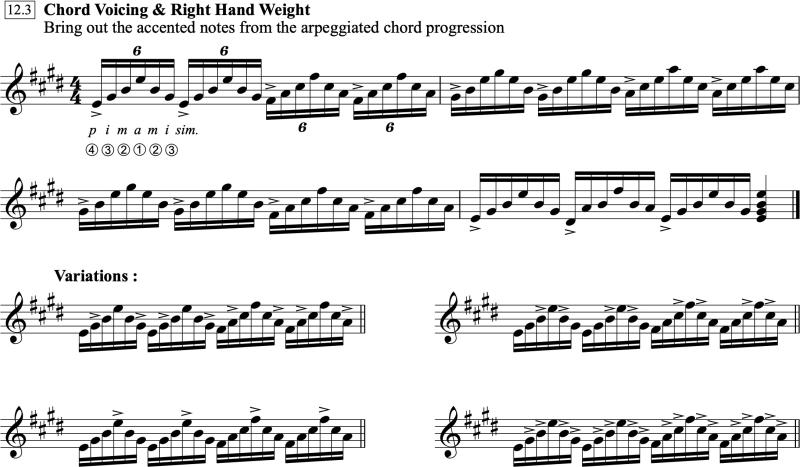
Solution:
This exercise trains you to control the voicing in your right-hand fingers. Again we’ll do this in two steps:
- What we will do to start is to play an arpeggio with a chord progression in the left hand and we will play p-i-m-a-m-i from the fourth to the first strings in the right hand. Each time we repeat this progression we will work to bring out a different finger. Accent the finger you want to bring out while making the other fingers soft.
- Next, let’s up the challenge by playing block chords. Just play p-i-m-a block chords with the same progression in the right hand, but each time bring out a different finger while the others stay soft.
Slurs
Problem:
We use slurs often in classical guitar music for musical purposes. They help to shape a phrase and give direction to a melody. But they can also be used for technical purposes, to play nice and fast without so many right-hand articulations.
Two problems emerge with slurs:
- When we have pairs of slurs, we tend to make the rhythm lopsided because slurs are fast. But we want them to be even.
- Between two notes there is sometimes a dynamic discrepancy, the first being loud and the second almost nothing.
Solution:
We can address both of these issues with the same exercise. Play two notes articulated, and then play the same two notes slurred. Every time you articulate the notes you benchmark the rhythm and sound and volume you want from the slurred notes. So you can try to match the same feel and sound when you slur the same notes.
Fixed Fingers
Problem:
In many situations in classical guitar music, however, we are often holding a finger down while slurring with other fingers.

Solution:
Fix the 2 finger to the sixth fret of the third string. The remaining fingers will perform pairs of slurs on the adjacent strings, starting with the fourth: 1-3, 3-4. Now keep the 2 fixed on the third string, but move the other fingers to the second string. Then move to the fifth, the sixth, and the first. Each time you are requiring differing amounts of stretch between the fingers. And you can of course fix any finger. So next try fixing 3 and play 1-2, 2-4 slurs.
But focus on the ones that need the most work. So if, for instance, you struggle with 2-3 or 3-4 slurs, fix the 1 finger and really focus in on the 2-3, 3-4 pattern.
Speed Bursts
Problem:
We all want to be able to play fast, but one common tendency when speeding up is to tense up in the hands.
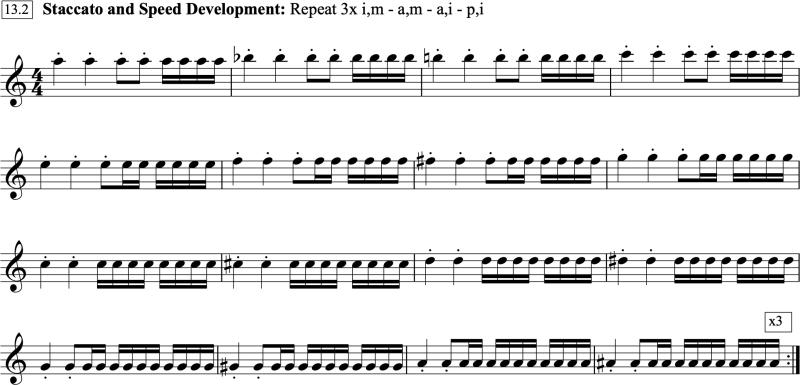
Solution:
This exercise combines speed bursts with staccato to train your hands to relax after every stroke. Here’s the exercise:
The left hand will play a 1-2-3-4 pattern starting on the first string, repeating the right-hand speed burst with each new finger in sequence.
The right hand will play with i-m alternation, playing staccato on the longer notes (quarters and eighths) and legato on the shorter (sixteenths).
This trains the fingers to play bursts of speed and then to relax the hand. The staccato prepares the fingers early, which empties them of tension and makes them more efficient.
Learn more about developing speed in the right hand.
Right-Hand Preparation
Problem:
Just as we struggle with left-hand flyaway fingers, we can also have issues with accuracy in the right hand. This is usually due to a lack of independence in the right hand.
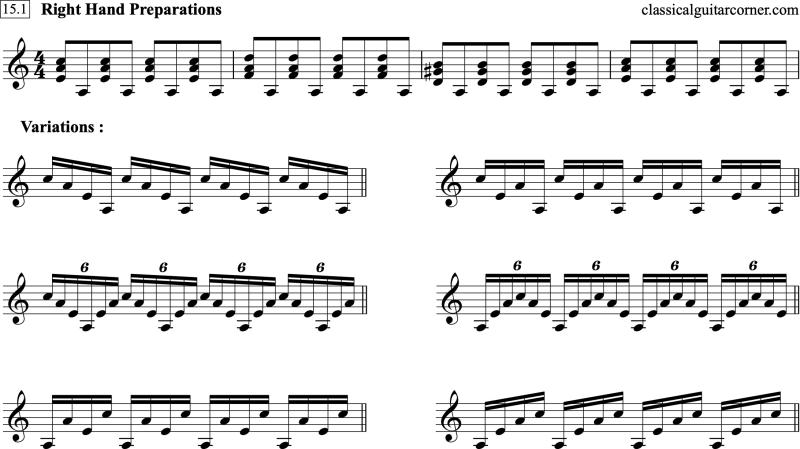
Solution:
This exercise trains your fingers to stay close to the string, like the staccato in the previous exercise. But here we’ll prepare fingers early across strings, not on the same string (like with staccato).
Play the chord progression in the left hand and to start we’ll play the thumb followed by an a-m-i block chord. Each time the p plays the a-m-i should prepare early on the string. Then, when a-m-i play, the p should prepare early.
Next, we’ll add variations to change the preparation. Start with a-m-i-p. Each time one finger plays, the next finger prepares on its string early. Then play different patterns: a-i-m-p, p-i-m-a-m-i, p-i-m-a, varying your preparation with each one.
Chromatic Octave Scale
Problem:
Just like with the last exercise, another way to control a lack of finger independence in the left hand is to use preparation.
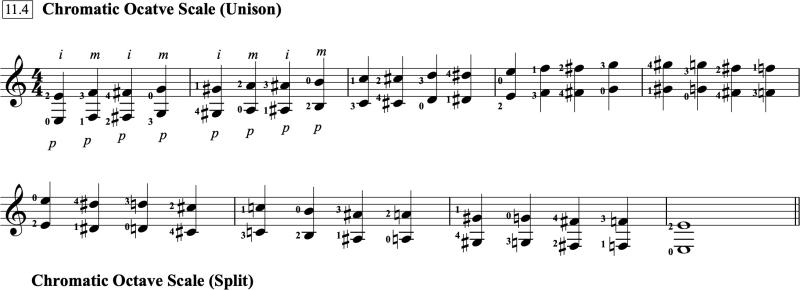
Solution:
We’ll play a chromatic octave scale. Each time one finger plays we start moving the next fingers in the sequence early. Hover them over the strings early. So this exercise essentially has your fingers thinking in the future.
This develops great left-hand independence. It also makes complex passages easier to play because your fingers are ready early.
This is a great warmup exercise as well, so it’s a part of our 5-minute warmup.
Check out more on left-hand preparation here.
***
Those are seven of our favorite and most useful classical guitar exercises to solve technical problems. Do you have a favorite exercise that helps you address technical problems? Share it in the comments below.
20 Practice Routines
All of these classical guitar exercises come from our book, 20 Practice Routines for Classical Guitar. You can pick up your own copy at the link to the right.
These 20 Practice Routines are designed to give a comprehensive technical workout at all levels of development (beginner/intermediate/advanced). These routines have been used by thousands of guitarists, teachers, and schools around the world and have been revised over an eight-year period. In addition to providing a comprehensive range of exercises that cover all aspects of technique, these routines allow you to simply open up the book and focus on what is important.

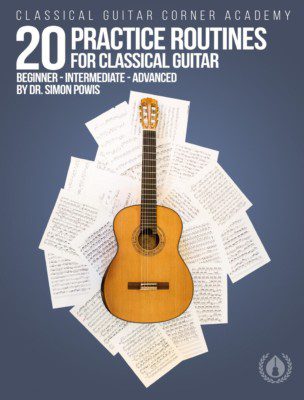
CGC IS THE BEST! THANK YOU. WHENEVER I TAKE A STUDY TO MY TEACHER, HE ALWAYS PICKS CGC! [AND HE IS AN EXCELLENT PROFESSIONAL CLASSICAL GUITARIST + TEACHER OF HIGH SCHOOL CLASSICAL GUITARISTS- HE NOW FAVORS THE BLUES GENRE, BUT TEACHES CLASSICAL GUITAR – ALBEIT HE HAS TAUGH ME A SIMPLE BLUES SCALE;] REMINDS ME OF AN OSCAR PETERSON QUOTE: “IF YOU LEARN CLASSICAL – YOU CAN PLAY ANY GENRE!”
Thank you for these great exercises. I find the slurs with fixed fingers particularly useful. I would like to share two right hand exercises I have found helpful:
1. Pami or pima on the same string. Then, I count to three and emphasize one, which then falls each time on a different finger.
2. Ami or ima also on the same string but now I count to four emphasizing one, which falls each time on a different finger.
Excellent lesson! Very instructive and very well structured.
Thank you Simon for sharing. I am returning to my CG studies after along time absence. This is just what I need to get back to the joy of playing! thank you again! I have been following you for a while ,but to shy to get involved. I see how you inspired so many others. Hopefully I will follow.
Best Salvatore
Excelent!
Simon I have been following you for years. Thank you for this summary of fantastic exercises. The video and written explanations are very thorough. We do some of these exercises in our community guitar ensemble. As always your technique recommendations help us all to be more mindful during practice with the goal of improving performance and avoiding injury 🎶.
Take care,
Karen
Thank you Simon very informative!